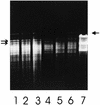Enterococcus faecalis gene transfer under natural conditions in municipal sewage water treatment plants
- PMID: 9464401
- PMCID: PMC106093
- DOI: 10.1128/AEM.64.2.626-632.1998
Enterococcus faecalis gene transfer under natural conditions in municipal sewage water treatment plants
Abstract
The ability of Enterococcus faecalis to transfer various genetic elements under natural conditions was tested in two municipal sewage water treatment plants. Experiments in activated sludge basins of the plants were performed in a microcosm which allowed us to work under sterile conditions; experiments in anoxic sludge digestors were performed in dialysis bags. We used the following naturally occurring genetic elements: pAD1 and pIP1017 (two so-called sex pheromone plasmids with restricted host ranges, which are transferred at high rates under laboratory conditions); pIP501 (a resistance plasmid possessing a broad host range for gram-positive bacteria, which is transferred at low rates under laboratory conditions); and Tn916 (a conjugative transposon which is transferred under laboratory conditions at low rates to gram-positive bacteria and at very low rates to gram-negative bacteria). The transfer rate between different strains of E. faecalis under natural conditions was, compared to that under laboratory conditions, at least 10(5)-fold lower for the sex pheromone plasmids, at least 100-fold lower for pIP501, and at least 10-fold lower for Tn916. In no case was transfer from E. faecalis to another bacterial species detected. By determining the dependence of transfer rates for pIP1017 on bacterial concentration and extrapolating to actual concentrations in the sewage water treatment plant, we calculated that the maximum number of transfer events for the sex pheromone plasmids between different strains of E. faecalis in the municipal sewage water treatment plant of the city of Regensburg ranged from 10(5) to 10(8) events per 4 h, indicating that gene transfer should take place under natural conditions.
Figures




Similar articles
-
The sex pheromone system of Enterococcus faecalis. More than just a plasmid-collection mechanism?Eur J Biochem. 1994 Jun 1;222(2):235-46. doi: 10.1111/j.1432-1033.1994.tb18862.x. Eur J Biochem. 1994. PMID: 8020463 Review.
-
Intergeneric transfer of the Enterococcus faecalis plasmid pIP501 to Escherichia coli and Streptomyces lividans and sequence analysis of its tra region.Plasmid. 2003 Jul;50(1):86-93. doi: 10.1016/s0147-619x(03)00044-1. Plasmid. 2003. PMID: 12826062
-
Natural transfer of conjugative transposon Tn916 between gram-positive and gram-negative bacteria.J Bacteriol. 1991 Jan;173(2):443-8. doi: 10.1128/jb.173.2.443-448.1991. J Bacteriol. 1991. PMID: 1846142 Free PMC article.
-
Enterococcus faecalis Sex Pheromone cCF10 Enhances Conjugative Plasmid Transfer In Vivo.mBio. 2018 Feb 13;9(1):e00037-18. doi: 10.1128/mBio.00037-18. mBio. 2018. PMID: 29440568 Free PMC article.
-
Properties of Enterococcus faecalis plasmid pAD1, a member of a widely disseminated family of pheromone-responding, conjugative, virulence elements encoding cytolysin.Plasmid. 2007 Nov;58(3):205-27. doi: 10.1016/j.plasmid.2007.05.001. Epub 2007 Jun 27. Plasmid. 2007. PMID: 17590438 Review.
Cited by
-
Harnessing bacteriocin biology as targeted therapy in the GI tract.Gut Microbes. 2016 Nov;7(6):512-517. doi: 10.1080/19490976.2016.1233089. Epub 2016 Sep 13. Gut Microbes. 2016. PMID: 27624536 Free PMC article.
-
Quantification and Multidrug Resistance Profiles of Vancomycin-Resistant Enterococci Isolated from Two Wastewater Treatment Plants in the Same Municipality.Microorganisms. 2019 Nov 29;7(12):626. doi: 10.3390/microorganisms7120626. Microorganisms. 2019. PMID: 31795349 Free PMC article.
-
Review of the occurrence of anti-infectives in contaminated wastewaters and natural and drinking waters.Environ Health Perspect. 2009 May;117(5):675-84. doi: 10.1289/ehp.11776. Epub 2009 Jan 22. Environ Health Perspect. 2009. PMID: 19479007 Free PMC article. Review.
-
Antibiotic resistance of enterococci in American bison (Bison bison) from a nature preserve compared to that of Enterococci in pastured cattle.Appl Environ Microbiol. 2008 Mar;74(6):1726-30. doi: 10.1128/AEM.02164-07. Epub 2008 Feb 1. Appl Environ Microbiol. 2008. PMID: 18245252 Free PMC article.
-
Sensitivity to detergents and plasmid curing in Enterococcus faecalis.J Ind Microbiol Biotechnol. 2006 Mar;33(3):238-42. doi: 10.1007/s10295-005-0261-y. Epub 2005 Jun 30. J Ind Microbiol Biotechnol. 2006. PMID: 15988583
References
-
- Booth M C, Bogie C P, Sahl H-G, Siezen R J, Hatter K L, Gilmore M S. Structural analysis and proteolytic activation of Enterococcus faecalis cytolysin, a novel lantibiotic. Mol Microbiol. 1996;21:1175–1184. - PubMed
Publication types
MeSH terms
Substances
LinkOut - more resources
Full Text Sources

